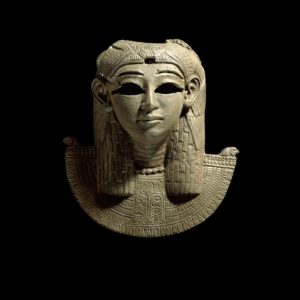
A Kushite Kandake
The Kingdom of Kush was located in ancient Nubia. This area is now known as southern Egypt and northern Sudan and was called ‘Ethiopia’ during the Classical period. While there is evidence of Nubian civilisations dating to 8000 BCE, the main archaeological evidence dates them to 3500 BCE. During the periods known as the Egyptian Old and Middle Kingdoms; the Nubian empire rivalled the Egyptian power. During the Second Intermediate Period, they temporarily took control of Lower Egypt. However, they were driven back by the Egyptian 18th Dynasty at the start of the New Kingdom.
When the New Kingdom collapsed in approximately 1070 BCE, the Kingdom of Kush became the dominant power in the Nubian region. In 727 CE, the Kushite King Piye launched a successful campaign in Egypt which led to the establishment of the 25th Dynasty of Pharaohs. They ruled until the 671 BCE invasion of Egypt by the Assyrians, which led to the eventual demise of the Kushite rule of Egypt by 654 BCE. Despite this and the sack of their capital Napata in 592 BCE, the Kingdom of Kush continued to survive in Nubia for a further 900 years with the creation of the city of Meroë.
This powerful kingdom was driven by women, with multiple rulers being female and earning the nickname of the “Kushite Queens”. These women were seen as being responsible for both their own rule and the establishment of their sons as rulers. They could also depose their sons should they wish. Royal women were also granted the power to order a king to commit suicide, a request that he was obliged to follow. These women were called a ‘Kandake’ or ‘Kandace’ depending on the source material. The addition of the word ‘Qore’ showed that she ruled independent of a king and was responsible for leading her own army.
The first Kandake is believed to be Makeda, who was thought to have ruled sometime between 1005 and 950 BCE, although the information is vague. Makeda is said to be the inspiration behind the biblical figure of the Queen of Sheba from the Old Testament, who dated to 1000 BCE and ruled Ethiopia. Unfortunately, her existence is yet to be confirmed by archaeological evidence.
Following on from Makeda was Shanakdakhete, who ruled approximately between 177 and 155 BCE. Shanakdakhete is the first confirmed ruling queen of the Kingdom of Kush and was said to have played a significant role in the Meroitic religion. This religion was heavily influenced by the ancient Egyptians as their central deity was Amun. This god was the creator found in Egyptian religion who later became known as Ra. Her only inscription is in the Meriotic language in her temple at Naqa, known as Temple F. This temple is unusual as it contains multiple interior partitions in the entrance chambers. It also contains all of the gods facing the back wall. A sandstone stele with a relief from her funerary temple can be found in the British Museum, and shows Shanakdakhete in front of Osiris.
The period between 40 BCE and 50 CE saw three Kushite Queens in succession; Amanirenas, Amanishakheto and Amanitore. Amanirenas was the most prominent Kandake and reigned between 40 and 10 BCE. She is most revered for leading the Kushite armies to victory against the Romans after a five -year war. She was initially victorious in her attempt to reclaim Roman Egypt for the Kingdom of Kush, however she was driven back by Petronius. Amanirenas was recorded as being a brave warrior queen who was blind in one eye in the Geographica by Roman author Strabo. He records that her ambassadors met with the Emperor and were granted all they desired.
This was said to be the withdrawal of Roman forces from the majority of Nubia and the revocation of the demand to pay tribute to the ruling emperor. This peace treaty lasted until the 3rd century CE.
Following her was Amanishakheto who ruled between 10 BCE and 1 CE. While nothing is known about her reign, an impressive collection of her jewellery was found in her pyramid by Giuseppe Ferlini in 1834. It remains on display in both the Egyptian Museum of Berlin and the Egyptian Museum of Munich.
Amanitore was the last Kandake of this period and ruled between 1 and 50 CE. Unlike Amanirenas and Amanishakheto, she was not a Qore and ruled alongside Natakamani who was either her husband or son. Amanitore was one of the last of the great builders of Kush and restored temples of Amun in both Meroë and Napata following their attack by the Romans. Despite building these Meriotic temples, she was mentioned in the New Testament during the conversion of the Ethiopians to Christianity.
The final Kandake before the Kingdom’s decline in 350 CE, was Amanikhatashan who ruled between 62 and 85 CE. She was known for leading her Kushite army into the First Jewish-Roman War in 70 CE to help Titus, who later became the Emperor in 79 CE.
The Kingdom of Kush was made up of powerful queens who held full autonomy over their people and armies. Their involvement with both the Egyptian and Roman superpowers shows their level of influence.
-Devon Allen
Junior Girl
Girl Museum Inc.
